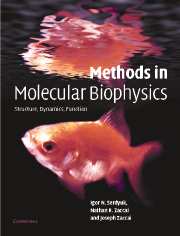Book contents
- Frontmatter
- Contents
- Foreword by D. M. Engelman
- Foreword by Pierre Joliot
- Preface
- Introduction: Molecular biophysics at the beginning of the twenty-first century: from ensemble measurements to single-molecule detection
- Part A Biological macromolecules and physical tools
- Part B Mass spectrometry
- Part C Thermodynamics
- Part D Hydrodynamics
- Part E Optical spectroscopy
- Part F Optical microscopy
- Part G X-ray and neutron diffraction
- Part H Electron diffraction
- Part I Molecular dynamics
- Part J Nuclear magnetic resonance
- References
- Index of eminent scientists
- Subject Index
Foreword by Pierre Joliot
Published online by Cambridge University Press: 05 November 2012
- Frontmatter
- Contents
- Foreword by D. M. Engelman
- Foreword by Pierre Joliot
- Preface
- Introduction: Molecular biophysics at the beginning of the twenty-first century: from ensemble measurements to single-molecule detection
- Part A Biological macromolecules and physical tools
- Part B Mass spectrometry
- Part C Thermodynamics
- Part D Hydrodynamics
- Part E Optical spectroscopy
- Part F Optical microscopy
- Part G X-ray and neutron diffraction
- Part H Electron diffraction
- Part I Molecular dynamics
- Part J Nuclear magnetic resonance
- References
- Index of eminent scientists
- Subject Index
Summary
As the authors of this book have written in the Introduction the ideal biophysical method would have the capability of observing atomic level structures and dynamics of biological molecules in their physiological environment, i.e. in vivo. Such a method does not exist, of course, and it will probably never exist because of insurmountable technical constraints. Characterisation of structural and functional properties of biological molecules requires the concerted application of an arsenal of complementary techniques. We note that in practice, however, many highly productive molecular biophysics groups are concerned by a single technique that they ‘push’ to its extreme limits. Such groups develop an essentially methodological approach, in which they seek to characterise by their technique as many biological molecules as they can. High-throughput crystallography or structural genomics is an example of this type of biophysics. Its aim is to provide a precious data base of information on three-dimensional protein structures, analogous to that on primary structures from genome sequence – a data base that will be used intensively by all biologists.
A different approach consists in tackling a biological problem with a multi-disciplinary approach, in which molecular biophysics plays a dominant role. The aim of this approach is to define as finely as possible the functional, structural, and dynamic properties of the molecules implicated in the physiological process as well as their interactions.
- Type
- Chapter
- Information
- Methods in Molecular BiophysicsStructure, Dynamics, Function, pp. xiii - xivPublisher: Cambridge University PressPrint publication year: 2007



